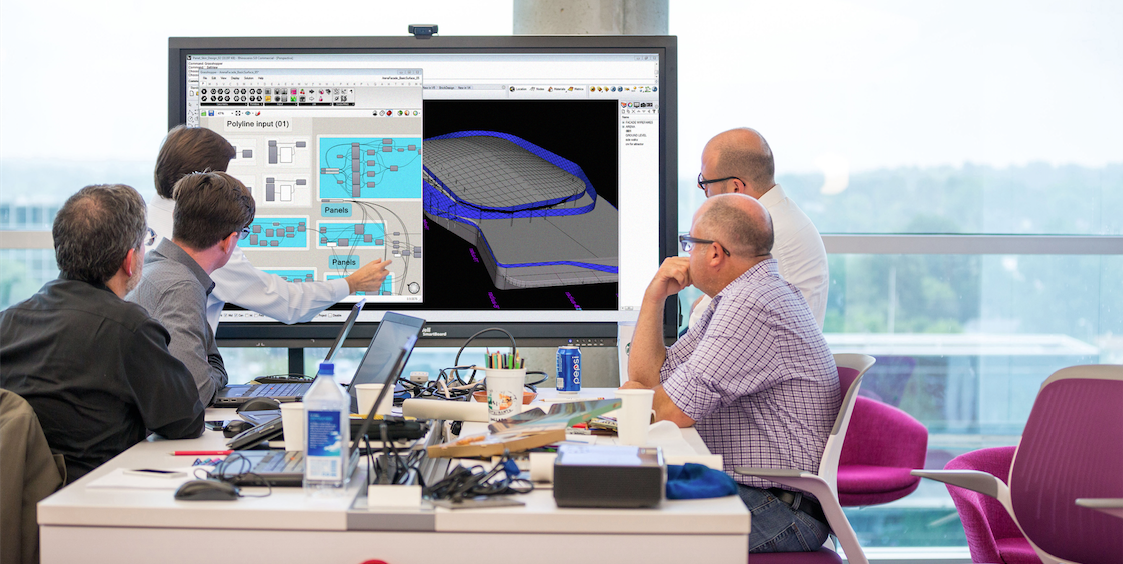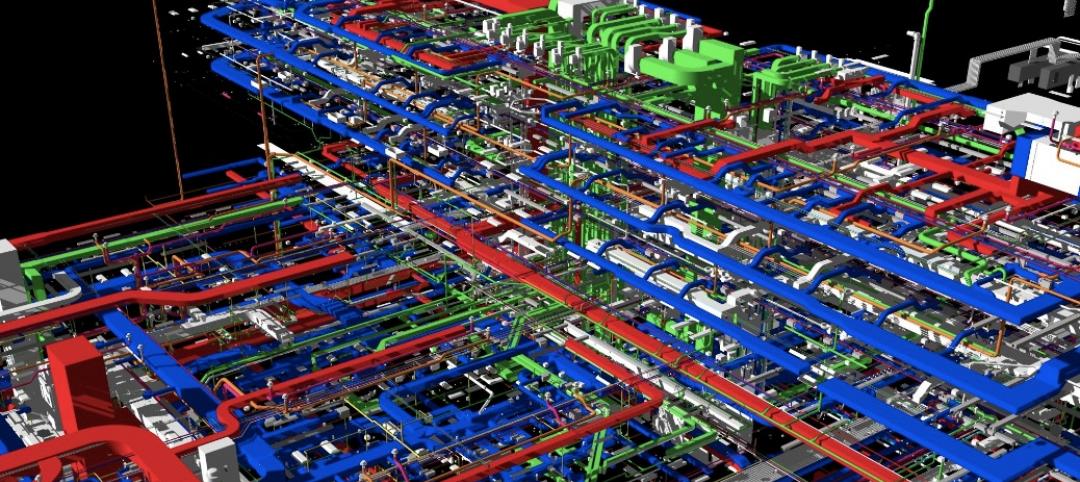Should architects learn to code? This question was posed by computational design consultant Nathan Miller, Founder and Managing Director of Proving Ground, in a recent blog post about the rise of data-driven design. Miller’s answer: “Well, maybe.”
While Miller and other computation experts don’t expect every design professional to become Mark Zuckerberg in “The Social Network” (“Don’t interrupt him. He’s plugged in!”), there is no denying the growing importance of the utilization of data and computation in the design process. HDR, NBBJ, Populous, Thornton Tomasetti, and Woods Bagot are among the firms that are investing in talent and training to advance their CD capabilities.
ALSO SEE
6 ways smart AEC firms are using computational design methods
During his four-plus years as a CD consultant, Miller has assisted these firms and others in developing a business roadmap for breaking into data-driven design. We asked him for tips and advice on getting started. He offered the following:
1. Define the business value of computational design. Computational design is an open-ended methodology, not a class of software tools with predefined features for a specific uses.The value of computation is greatly dependent on how well an AEC organization positions the new skill sets, tools, and workflows relative to the business.
“I’m often confronted with questions akin to some variation of, ‘Can Grasshopper or Dynamo do X,’” says Miller. “The reality is quite the opposite: Computational design is about the process of creating solutions. The question is better framed as, ‘What can we create that will help us better solve X design problem?’”
It could involve developing an algorithm that can greatly increase the speed of solving repetitive design problems, or creating a tool for a project or market that can provide an advantage for a firm looking to differentiate its services in a competitive marketplace.
For CD to be meaningful to a business at scale means determining the desired outcomes, coupled with a strategic framework for developing a team capable of creating high-impact solutions, says Miller.
2. Pilot computational design services in the areas where your firm takes the most risks. AEC firms tend to be risk adverse when it comes to changing process. Factor in increasingly tighter deadlines and shrinking fees, and it can make computational design a hard sell to firm leaders.
‘Design organizations should be looking for do-it-yourself creative thinkers that have a knack for making digital tools.’
—Nathan Miller, Proving Ground
Miller says a number of his AEC clients have had success winning over firm leaders and scaling up CD operations by piloting these tools and processes in the areas of the practice where the firm traditionally takes more risks, namely project pursuits, RFPs, and design competitions.
“When you know you’re going up against strong competition and you want to take some calculated risks, those become very good entry points for computational design,” says Miller. “By going the computation route with an RFP or competition submission, it may allow the firm to explore a problem a little differently, or capture that process and fold it into the overall narrative.”
Win a few projects and light bulbs will start going off throughout the practice.
3. Hire for passion of building design, not for coding prowess. It’s much tougher to teach a game designer or software engineer about the building design process than it is to teach an architect or engineer basic coding skills. Many firms, however, are looking to the tech markets—computer science, simulation, software engineering, game development—to build their CD teams.
“Where the real moment with computational design concepts comes to bear is when you engage the opposite—give a couple of designers who are really passionate about buildings the skills to be able to code,” says Miller.
He has advised AEC clients to modify their job requisitions for entry-level designers coming out of school to include skill sets like experience with computational design software. “If you’re a firm looking to grow your CD capability, you need to change the demographic of the people applying for the position,” says Miller.
4. Invest in people, not software. Computational design software is a drop in the bucket compared to the six- and seven-figure investments firms have had to make in CAD and BIM software tools. Grasshopper is a free plug-in. Dynamo is open source. The tools are essentially free. The real investment is in finding the right people and then advancing their computation capabilities.
“As with most things that drive success in service organizations, people should be the focus of business investment for executing a successful computational design strategy,” says Miller. “Design organizations should be looking for do-it-yourself creative thinkers that have a knack for making digital tools.”
5. Apply the 70/20/10 ratio when assembling your computation-enabled design team. While no two firms are the same, Miller has discovered a sweet spot for the makeup of computation-enabled design teams: the 70/20/10 ratio. Seventy percent should have enough working knowledge to be able to “pull the levers” on pre-made computational tools; 20% should have a high comfort level with building simple tools and modifying complex project algorithms; 10% should have an advanced skill set in creating sophisticated tools and solutions.
Having a team with a range of skill sets, says Miller, will encourage broader participation, skill growth, and engagement across the organization.
Project leaders and firm management need to be active participants in the implementation process. “They don’t need to know the nuts and bolts of the tools, but they do need to understand how the project process is changing so they can give the team a platform to deliver valuable design solutions,” says Miller.
For more on computational design, read Proving Ground’s blog.
Related Stories
| Oct 18, 2013
A picture’s worth a thousand words… if you can find it
Photographs are becoming more essential to project communication and documentation. Recently, I sat in a local airport integration project meeting in which the owner outlined their expectation for construction documentation. One of the first requirements was to provide photographs throughout the building process.
Sponsored | | Oct 7, 2013
Bridging the digital divide between the BIM haves and have nots
There's no doubt that BIM is the future of design. But for many firms, finding a bridge to access rich model data and share it with those typically left on the sidelines can be the difference between winning a bid or not.
| Oct 2, 2013
Corporate HQ in 10 months made possible with BIM coordination
An integrated Building Team uses BIM/VDC to convert a 1940s-era industrial building into a flashy new headquarters for Hillshire Brands in a matter of months.
| Sep 26, 2013
Mobilizing your job site to achieve a paperless project: fact or fiction?
True mobility in the field has rapidly evolved from lock-box kiosks on each floor to laptops on rolling carts to tablets and iPads loaded with drawings sets stored in the cloud. And WiFi-ready job sites have gone from “nice to have” to “must have” status in just a little over a year.
| Sep 4, 2013
Augmented reality: 12 applications for design and construction professionals
Building Design+Construction reached out to AEC professionals who have studied and applied augmented reality and asked them to pinpoint applications that are ripe for the technology. Here’s what they had to offer.
| Sep 4, 2013
Augmented reality goes mainstream: 12 applications for design and construction firms
Thanks to inexpensive mobile devices and increasingly advanced software apps, Building Teams are finally able to bring their BIM models to life on the job site.
| Sep 4, 2013
Smart building technology: Talking results at the BUILDINGChicago/ Greening the Heartland show
Recent advancements in technology are allowing owners to connect with facilities as never before, leveraging existing automation systems to achieve cost-effective energy improvements. This BUILDINGChicago presentation will feature Procter & Gamble’s smart building management program.
| Aug 8, 2013
Level of Development: Will a new standard bring clarity to BIM model detail?
The newly released LOD Specification document allows Building Teams to understand exactly what’s in the BIM model they’re being handed.
| Jul 19, 2013
Top BIM Construction Firms [2013 Giants 300 Report]
Turner, Clark Group, DPR top Building Design+Construction's 2013 ranking of the contractors and construction management firms with the most revenue from BIM-driven projects.
| Jul 19, 2013
Top BIM Engineering Firms [2013 Giants 300 Report]
Jacobs, URS, SAIC top Building Design+Construction's 2013 ranking of the engineering and engineering/architecture firms with the most revenue from BIM-driven projects.

















